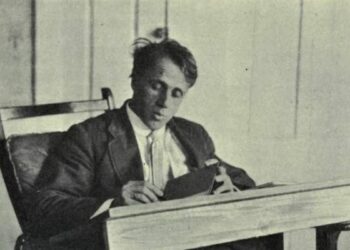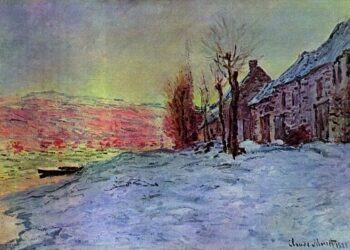Poem Summary Fear by Gabriela Mistral Line by Line Explanation – Gabriela Mistral’s poem “Fear” is a poignant exploration of the emotion that can grip the human soul. In this poem, Mistral delves deep into the various facets of fear, its origins, and its effects on the human psyche.
ABOUT AUTHOR
Gabriela Mistral, whose real name was Lucila Godoy Alcayaga, was a Chilean poet, educator, diplomat, and feminist. She was born on April 7, 1889, in Vicuña, Chile, and died on January 10, 1957, in Hempstead, New York, United States. Mistral was the first Latin American to receive the Nobel Prize in Literature, which she was awarded in 1945.
Mistral’s poetry is known for its deep emotional resonance, exploring themes such as love, sorrow, motherhood, and nature. Her work often reflects her own personal experiences and struggles, including the loss of her beloved nephew, Juan Miguel Godoy. Mistral’s writing is characterized by its simplicity and lyricism, as well as its exploration of the human condition.
In addition to her poetry, Mistral was also a dedicated educator and diplomat. She worked as a teacher and school administrator in Chile, Mexico, and the United States, and she was a strong advocate for education, particularly for women and children. Mistral also served as a diplomat for the Chilean government, representing her country at the League of Nations and the United Nations.
Summary Fear by Gabriela Mistral Line by Line Explanation
1. “Fear of a handful of dust, of a tuft of grass, of an owl’s eye, of a handful of dew.”
Mistral begins her poem by listing seemingly innocuous things that evoke fear. The mention of a “handful of dust” and “a tuft of grass” suggests that fear can arise from mundane, everyday objects. Even natural elements like “an owl’s eye” or “a handful of dew” become sources of fear. These examples highlight the irrational and varied nature of fear.
2. “Fear the rosebush, fear the horse and the sea, fear the still pool.”
Here, Mistral continues to enumerate objects of fear. The rosebush, horse, sea, and still pool are all natural elements, yet they inspire fear. The repetition of the word “fear” emphasizes the pervasive nature of this emotion, suggesting that fear can be found everywhere, even in the beauty of nature.
3. “Fear the flat, calm beach, fear the steep mountain, fear the sea, fear the flowerpot.”
Mistral expands on the theme of fearing nature, including both calm and turbulent landscapes. The repetition of “fear the sea” emphasizes the power and unpredictability of nature. Even a seemingly benign object like a flowerpot becomes a source of fear in Mistral’s evocative imagery.
4. “Fear the heap of stones, fear the dry well, fear the tractor parked in the woods.”
In this stanza, Mistral introduces man-made objects as sources of fear. The heap of stones, dry well, and tractor parked in the woods all represent human intervention in nature, yet they evoke fear. This suggests that fear is not only tied to the unknown but also to the known and the familiar.
5. “Fear the horse’s horn, fear the sound of the long horn that echoes in the hill, the long horn that echoes in the valley.”
Mistral now introduces sounds as sources of fear. The horse’s horn and the echoing sound of the long horn create an atmosphere of unease. The repetition of “fear the sound” emphasizes the power of sound to evoke fear.
6. “Fear the quick, slow-beating drum and the terrible silence of the grasses.”
Here, Mistral contrasts the quick, rhythmic beat of a drum with the silence of the grasses. Both evoke fear, highlighting the diverse ways in which fear can manifest itself. The juxtaposition of sound and silence adds to the eerie atmosphere of the poem.
7. “Fear the vast, luminous, and silent night; fear the sound of the moon’s horn, and the icy stare of the winter sun.”
Mistral now turns to the fear of celestial bodies and natural phenomena. The vast, luminous, and silent night inspires fear, as does the sound of the moon’s horn and the icy stare of the winter sun. These images evoke a sense of primal fear, rooted in the elemental forces of nature.
8. “Fear the one who passes in silence and never speaks, and the other who murmurs, and the one who shouts and commands; fear the little mouse’s claw, the bird’s beak, and the lion’s claw.”
In this stanza, Mistral explores the fear of other people and animals. Whether they pass in silence, murmur, or shout and command, they all evoke fear. Even the seemingly harmless claws of a mouse, bird, or lion inspire fear, highlighting the universal nature of this emotion.
9. “Fear the great, towering lighthouse, and the small, trembling flame of the oil lamp.”
Mistral contrasts the towering lighthouse with the small, trembling flame of the oil lamp, both of which evoke fear. This suggests that fear can arise from both the grand and the humble, the powerful and the weak.
10. “Fear the swift ship and the vast storm, fear the storm’s eye, fear the vessel’s wake.”
Here, Mistral explores the fear of natural disasters, such as storms at sea. The swift ship, vast storm, and the storm’s eye all inspire fear, as does the vessel’s wake. These images evoke a sense of the overwhelming power of nature.
11. “Fear the high, calm, sunlit wall, and fear the narrow path through the thickets.”
Mistral contrasts the high, calm, sunlit wall with the narrow path through the thickets, both of which evoke fear. This suggests that fear can arise from both the open and the confined, the familiar and the unknown.
12. “Fear the walk through the dry forest, and fear the walk through the wet forest, fear the sea, fear the high mountains.”
In this stanza, Mistral returns to the fear of nature, including both dry and wet forests, as well as the sea and high mountains. These natural landscapes evoke a sense of fear and awe, highlighting the power and unpredictability of nature.
13. “Fear the roar of the lion, and the whisper of the serpent, fear the knife in the coward’s hand, fear the rope in the hand of the executioner.”
Mistral explores the fear of other living beings, including lions and serpents, as well as the fear of human violence, such as a knife in the coward’s hand or a rope in the executioner’s hand. These images evoke a sense of primal fear, rooted in the struggle for survival.
14. “Fear the multitude, the enemy, the friend; fear the husband, the child, the wife, the widow, the mother.”
Mistral explores the fear of other people, including friends, family, and strangers. The mention of the multitude, enemy, friend, husband, child, wife, widow, and mother suggests that fear can arise in any relationship, highlighting the complex nature of human emotions.
15. “Fear the crowds that fill the streets and the empty rooms; fear the crowds that fill the empty rooms.”
Mistral contrasts the fear of crowds in the streets with the fear of empty rooms filled with crowds. This suggests that fear can arise from both the presence and absence of other people, highlighting the pervasive nature of this emotion.
16. “Fear the crying, whimpering child, fear the crying, whimpering adult; fear the tear-streaked face, and the laughing face.”
Mistral explores the fear of emotional expression, including crying, whimpering, tear-streaked faces, and laughing faces. These images evoke a sense of vulnerability and uncertainty, highlighting the complex nature of human emotions.
17. “Fear the one who walks alone, and the one who walks in a group; fear the one who sleeps alone, and the one who sleeps in a group.”
Mistral contrasts the fear of being alone with the fear of being in a group. This suggests that fear can arise from both solitude and company, highlighting Poem Summary Fear by Gabriela Mistral Line by Line Explanation

















